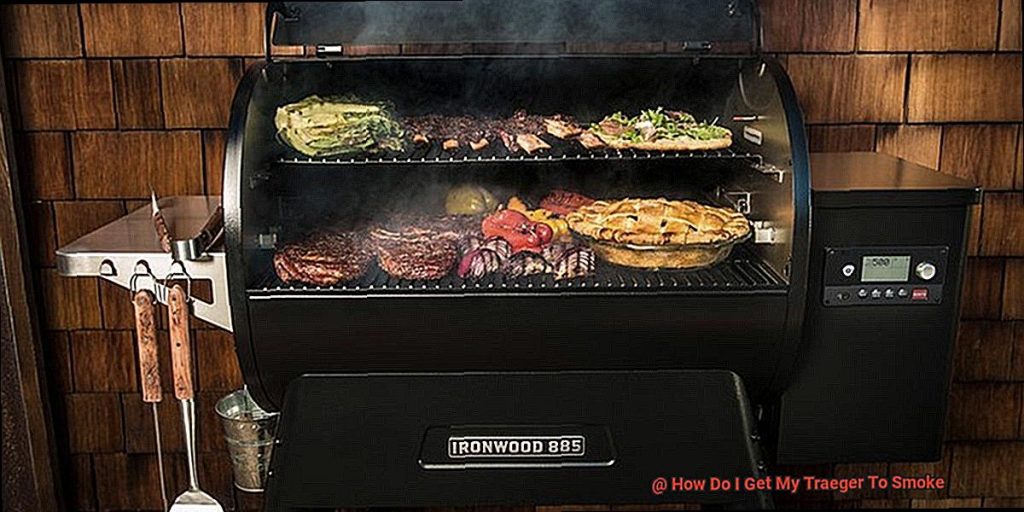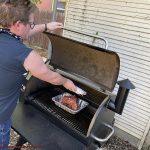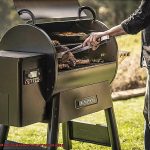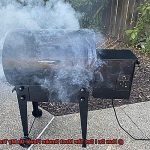Do you ever find yourself staring at your Traeger grill, wondering why your food isn’t coming out with that perfect smoky flavor? You’re not alone. Many people struggle to achieve that ideal smoke, especially when using a pellet grill like the Traeger. But don’t worry, my grilling friend – we’ve got you covered.
In this post, we’ll be sharing all of our expert tips and tricks for getting your Traeger to smoke like a pro. We’ll start by discussing the importance of choosing the right type of pellets for your grill. Did you know that different pellets produce different levels of smoke? We’ll reveal which ones will give you that maximum smoky goodness.
But it’s not just about the pellets – technique is important too. That’s why we’ll dive into the art of ‘offset smoking’ and explain how to maintain the perfect temperature for achieving that mouthwatering smoke. Plus, we’ll share some other insider tips and tricks for smoking on a Traeger that will have you grilling like a master in no time.
So whether you’re smoking up some brisket, pork shoulder or delicious ribs, this post has got everything you need to know about getting your Traeger to produce that perfect smoky flavor. Let’s get started and make your next meal a hit.
Contents
The Different Types of Wood Pellets for Smoking
Smoking meat is an art form, and selecting the right wood pellets is crucial in achieving a delicious end product. Traeger offers a wide variety of wood pellet flavors, each with its own unique taste profile. Here are five sub-sections that will help you understand the different types of wood pellets for smoking and their distinct flavors:
Hickory Wood Pellets
Hickory is one of the most popular types of wood pellets for smoking, and for a good reason. It has a bold, smoky flavor that pairs perfectly with beef, pork, and poultry. The strong, earthy taste of hickory adds complexity to the meat and creates a deep, rich color.
Mesquite Wood Pellets
Mesquite is another popular flavor that provides a bold, earthy taste that works well with red meats like beef and lamb. However, mesquite can be overpowering when used on its own, so it’s best to use it sparingly or mix it with milder flavors.
Applewood Pellets
If you’re smoking poultry or pork, applewood pellets are an excellent option. Applewood has a sweet, fruity flavor that adds a subtle sweetness to your meat without overwhelming it. It’s perfect for creating a tangy taste profile in your dishes.
Alder Wood Pellets
Alder wood pellets have a mild, delicate taste that works wonders with fish and poultry. It is also ideal for smoking vegetables and other delicate foods. Alder wood imparts a subtle smoky flavor without overpowering the natural flavor of the food.
Cherry Wood Pellets
Cherry wood gives off a unique sweet and slightly tart flavor that pairs well with pork and poultry. It’s perfect for creating a subtle yet delicious taste profile on your meat.
When choosing wood pellets for smoking, it’s essential to keep in mind that Traeger offers both hardwood and fruitwood pellets. Hardwood pellets are made from 100% hardwood and are perfect for smoking meats and other hearty dishes. Fruitwood pellets, on the other hand, are a blend of hardwood and fruitwood and are ideal for smoking delicate foods like fish or vegetables.
In conclusion, experimenting with different wood pellet flavors is essential to finding the perfect match for each dish you cook. With so many options available, you can create a unique flavor profile that suits your taste buds.
Preparing the Traeger Grill for Smoking
As an expert, I’m here to guide you through the process and ensure that you have a successful smoking experience.
Before we delve into the nitty-gritty details, let’s make sure your grill is clean and free from any debris or residue from previous grilling sessions. Trust me, this will ensure that your meat is cooked evenly, and no unwanted flavors are added to your meal.
Now, let’s get started with the fun part. First, fill the hopper with wood pellets of your choice. Traeger offers a range of options such as hickory, mesquite, apple, and cherry. Your choice of wood pellets will depend on the flavor profile you want to achieve. For instance, if you’re smoking beef or pork, hickory might be the perfect choice. If you’re smoking poultry or pork, try applewood for a sweet and fruity flavor.
Once the hopper is filled with pellets, turn on your Traeger grill and set it to smoke mode. This will allow the pellets to heat up and start producing smoke.
While your grill is heating up, place a drip tray underneath the grill grates to catch any drippings from the meat. This will prevent flare-ups and ensure even cooking.
Now it’s time to add your meat to the grill grates and close the lid. It’s important to monitor the temperature throughout the smoking process and adjust as needed to maintain a consistent temperature. This will ensure that your meat is cooked evenly, and no areas are overcooked or undercooked.
If you want to enhance the flavor of your meat, you can add more wood pellets during the smoking process. However, be cautious when opening the lid as it can cause a sudden burst of heat and smoke.
In conclusion, preparing your Traeger grill for smoking requires attention to detail and patience. By following these steps, you’ll be well on your way to achieving perfectly smoked meat every time. To recap, here’s a quick checklist:
Understanding the P-Setting for Smoke Production
If you want to take your smoking game to the next level on your Traeger grill, look no further than the P-Setting. As an expert on Traeger grills, I’m here to guide you through understanding the P-Setting for smoke production.
The P-Setting, or “pause” setting, is a powerful feature on Traeger grills that controls the amount of smoke produced during cooking. By adjusting the P-Setting, you can control the intensity of the smoke flavor in your food. However, it’s essential to keep in mind that the P-Setting is not a temperature control; instead, it regulates the length of time the auger pauses between pellet drops.
So how do you use the P-Setting to achieve maximum smoke production? First, set your Traeger grill to a low temperature of around 180-200 degrees Fahrenheit. Next, adjust the P-Setting to its highest setting (10) for an intense smoky flavor that’s perfect for meats like brisket or pork shoulder that can handle a lot of smoke.
But what if you prefer a more delicate smoke flavor or are cooking vegetables or fish that may not require a lot of smoke? In that case, adjust the P-Setting accordingly and lower it to around 2-This will produce less smoke and ensure that you don’t overpower these subtle flavors.
To summarize, understanding and adjusting the P-Setting on your Traeger grill is crucial to achieving the perfect amount of smoke for your desired flavor profile. Here are some key takeaways:
- The P-Setting controls the amount of smoke produced during cooking
- It’s not a temperature control
- The higher the P-Setting number, the more smoke is produced
- A lower P-Setting is best for delicate foods or when you want a milder smoke flavor
- Experiment with different settings to find your perfect smoke level
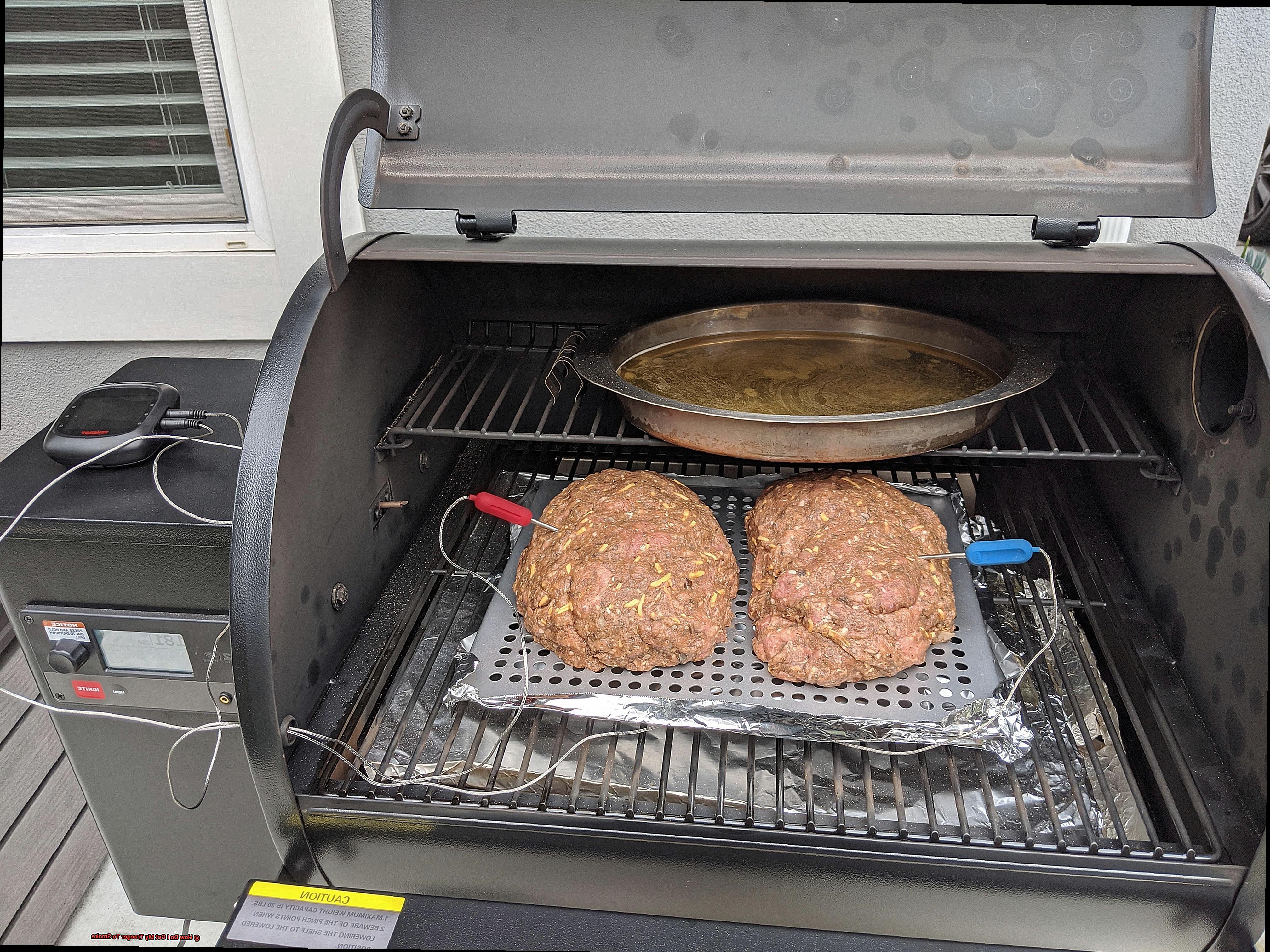
How to Fill the Hopper with Wood Pellets
One of the most important steps to achieving deliciously smoked food on your Traeger grill is to fill the hopper with wood pellets correctly. Here are five sub-sections to guide you through the process:
Choose High-Quality Wood Pellets for Smoking
The type of wood pellet you choose will impact the flavor of your food, so it’s essential to pick the right one. Traeger offers a variety of wood pellets made from different types of wood, such as hickory, mesquite, apple, and cherry. Each type of pellet has a unique flavor profile, so choose one that complements the dish you are cooking. Ensure that the wood pellets you use are high-quality and specifically designed for grilling and smoking.
Fill the Hopper Evenly
To fill the hopper, lift the lid and pour the wood pellets into it. Distribute the wood pellets evenly in the hopper to ensure consistent smoke output. Using a scoop or funnel can make this task easier.
Avoid Overfilling and Clean the Hopper Regularly
It’s essential not to overfill the hopper as this can cause an overflow and lead to a fire hazard. Only fill it about 3/4 full to avoid any problems. After each use, empty any remaining wood pellets from the hopper and wipe down the inside with a clean cloth to keep it free from debris.
Preheat Your Traeger Grill
Once you have filled the hopper with wood pellets, close the lid and turn on your Traeger grill. Set the temperature to your desired level and allow it to preheat for about 10-15 minutes. During this time, the Traeger will automatically feed pellets into the firepot, which will ignite and create smoke.
Monitor Pellet Levels During Cooking
Keep an eye on pellet levels during cooking to avoid running out mid-cook. If necessary, top up the hopper with more wood pellets.
Setting the Temperature for Optimal Smoky Flavor
Look no further than setting the temperature correctly on your Traeger grill. But be warned, it’s not as simple as “set it and forget it.” Let me guide you through the ins and outs of setting the temperature for optimal smoky flavor.
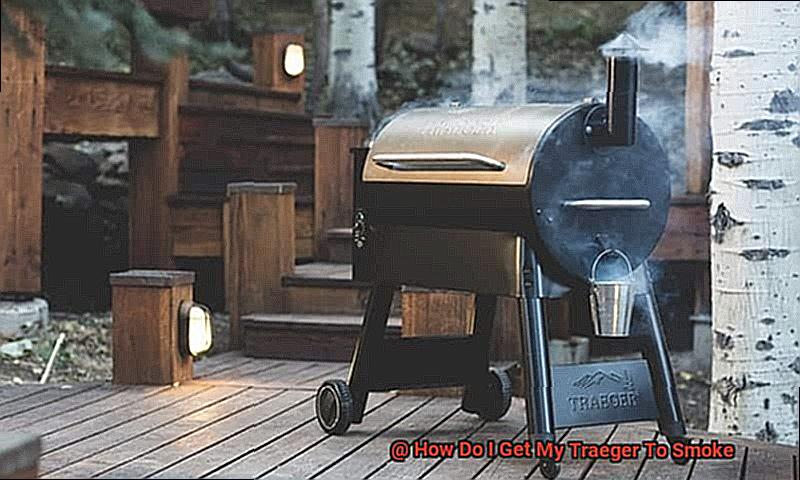
Firstly, the temperature you select is dependent on the type of wood pellets you are using and the desired level of smokiness. For a subtle smoky flavor, set your Traeger to 180°F – 225°F. This temperature range is perfect for smoking fish, poultry, and vegetables. However, if you’re looking for a more robust smoky flavor, increase the temperature to 250°F – 275°F. This range is ideal for smoking meats such as pork shoulder or brisket.
But wait, there’s more. The temperature you set your Traeger to will affect the cooking time. A lower temperature will result in a longer cooking time, while a higher temperature will reduce the cooking time. So be sure to plan accordingly and give yourself enough time to create that perfect dish.
Now, let’s talk wood pellet flavors. Different types of wood pellets will produce different levels of smokiness and flavor. For instance, hickory and mesquite wood pellets are known for their strong and bold flavors, while apple and cherry wood pellets produce a milder, sweeter smoky flavor. Take some time to experiment with different wood pellet flavors to find what works best for your taste buds.
Placing Food on the Grill Grates Properly
However, before placing your food on the grill grates, ensure the grates are clean and seasoned. This will prevent sticking and ensure that your food cooks evenly.
When it comes to spacing out your food, remember not to overcrowd or let them touch each other. Overcrowding can cause uneven cooking and potential flare-ups. Therefore, leave some space between each piece of food, whether it’s meat, veggies, or anything else.
Temperature is also a crucial factor to consider when placing your food on the grill grates. Different types of food require different temperatures, so it’s important to do some research beforehand or consult a recipe to ensure you’re cooking at the right heat. In general, thicker cuts of meat will require lower temperatures to cook evenly all the way through.
Moreover, accessories like grill baskets or skewers can help with placement and even cooking. These tools make it easier for you to place your food just right on the grill grates and prevent smaller pieces from falling through the cracks.
To sum up, here are some tips for placing food on the grill grates properly:
- Clean and season the grates before cooking
- Properly space out your food
- Consider the temperature of your grill
- Use accessories like grill baskets or skewers
Experimenting with Different P-Settings
Then it’s time to experiment with different P-settings, my friend. P-settings are the temperature control settings on your Traeger grill that control the amount of smoke produced by your grill. By adjusting these settings, you can achieve the perfect level of smokiness for your grilled foods.
To start experimenting with P-settings, begin by selecting a low temperature setting such as P1 or PThese settings produce more smoke than higher temperature settings, so you’ll get that delicious smoky flavor in no time. Before you add any food, let your grill preheat for 10-15 minutes. This will ensure that your grill is ready to smoke your food to perfection.
Once your grill is preheated and ready, add your food to the grill and monitor the smoke production closely. If you find that there isn’t enough smoke, try lowering the temperature setting even further. On the other hand, if there is too much smoke and it’s overpowering your food, consider increasing the temperature setting slightly.
It’s important to note that the type of wood pellets you use will also impact the level of smoke produced by your Traeger. There are many different types and flavors of wood pellets available, so don’t be afraid to try out different ones until you find one that suits your taste buds.
Aside from experimenting with P-settings, there are some other basics to keep in mind when grilling on a Traeger. Make sure to give your grill grates a good scrub and seasoning before cooking. This will prevent your food from sticking and ensure that it cooks evenly. Additionally, give your food some breathing room on the grill and consult a recipe or do some research on the right temperature for your particular cut of meat. And if you want to take things up a notch, consider using accessories like grill baskets or skewers.
Tips and Tricks for Getting Your Traeger to Smoke Perfectly
With the right tips and tricks, you can achieve perfectly smoked meats every time. Here are five sub-sections to help you get started.
Start with High-Quality Wood Pellets
To get that perfect smoky flavor, start with high-quality wood pellets. The type of wood you choose will impact the taste of your meat. Strong flavors like hickory and mesquite work well with beef, while fruitwoods like apple and cherry provide a milder taste that pairs well with poultry and pork.
Preheat Your Traeger Grill
To get the most flavor out of your wood pellets, preheat your Traeger grill to the desired temperature before adding your meat. This allows the pellets to ignite and produce smoke, giving your meat that smoky flavor. You can also add a smoke tube filled with wood pellets to enhance the smoke flavor.
Maintain a Consistent Temperature
Maintaining a consistent temperature is crucial in getting your Traeger to smoke perfectly. Monitor the temperature regularly and adjust the settings accordingly to maintain a consistent temperature throughout the cooking process. Avoid opening the lid frequently as this can cause fluctuations in temperature and add cooking time.
Use a Drip Tray or Aluminum Foil
Using a drip tray or aluminum foil to catch any drippings from the meat prevents flare-ups, which can cause uneven cooking and affect the smoke flavor. Plus, it makes clean-up a breeze.
Let Your Meat Rest
After smoking, let your meat rest for a few minutes to allow the juices to distribute evenly. This helps to enhance the flavor and tenderness of the meat. Don’t skip this step as it can make all the difference in achieving perfectly smoked meats on your Traeger grill.
wz9SCmyY5NA” >
Conclusion
In conclusion, achieving that mouthwatering smoky flavor on your Traeger grill is easier than you think. With these expert tips and tricks, you’ll be able to produce perfectly smoked meats every time.
The first step to getting that unique taste profile is choosing the right type of wood pellets for smoking. Experiment with different flavors and blends until you find one that tantalizes your taste buds. Preparing your Traeger grill for smoking requires attention to detail and patience, but the end result is worth it.
Don’t forget about the P-Setting – a powerful feature on Traeger grills that controls the amount of smoke produced during cooking. Adjusting the P-Setting can control the intensity of the smoke flavor in your food.
Properly placing food on the grill grates, experimenting with different P-settings, and maintaining a consistent temperature are all crucial steps in getting your Traeger to smoke perfectly. And don’t rush it. Letting your meat rest after smoking enhances its flavor and tenderness.
By following these tips and tricks, you’ll soon become a master at smoking on a Traeger grill.

